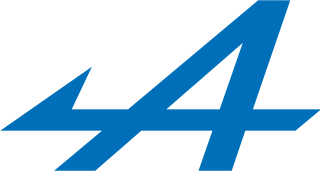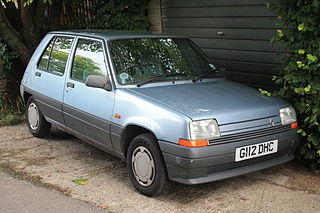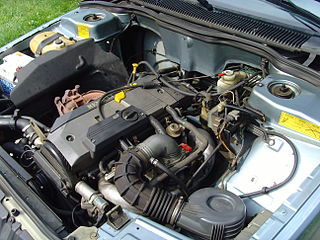
The Société des Automobiles Alpine SAS, commonly known as Alpine, is a French manufacturer of sports cars and racing cars established in 1955. The Alpine car marque was created in 1954.

The V6 PRV engine is an automobile petrol V6 engine that was developed jointly by Peugeot, Renault and Volvo Cars – and sold from 1974 to 1998. It was gradually replaced after 1994 by another joint PSA-Renault design, known as the ES engine at PSA and the L engine at Renault. It was designed and manufactured by the company "Française de Mécanique" for PSA, Renault and Volvo.

The Peugeot 504 is a mid-size, front-engine, rear-wheel-drive automobile manufactured and marketed by Peugeot from 1968 to 1983 over a single generation, primarily in four-door sedan and wagon configurations – but also as twin two-door coupé and cabriolet configurations as well as pickup truck variants.

The Renault 5 is a five-passenger, three or five-door, front-engine, front-wheel drive hatchback supermini manufactured and marketed by the French automaker Renault over two generations: 1972–1985 and 1984–1996.

The Renault 25 is an executive car produced by the French automaker Renault from 1983 to 1992.

The Billancourt engine was an automotive engine designed by Renault for the Renault 4CV, used subsequently until 1985. It later received the internal code "B", for Billancourt. The "sport" version is called Ventoux engine.

The Renault 5 Turbo or R5 Turbo is a sport hatchback automobile launched by the French manufacturer Renault at the Brussels Motor Show in January 1980. The car was primarily designed for rallying, but was also sold in a street version.

The Alpine A110 is a sports car produced by French automobile manufacturer Alpine from 1963 to 1977. The car was styled as a "berlinette", which in the post-WWII era refers to a small enclosed two-door berline, better-known as a coupé. The Alpine A110 succeeded the earlier A108. The car was powered by a succession of Renault engines. A car also named Alpine A110 was introduced in 2017.

The Renault 20(R20) and Renault 30(R30) are two executive cars produced by the French automaker Renault between 1975 and 1984. The most upmarket and expensive Renaults of their time, the two cars were almost identical with regard to sheet metal and mechanicals; the R30 was the larger-engined and more expensive of the two. The two cars were easily distinguished between each other from their differing headlight configuration – the Renault 20 had two single rectangular headlights, whereas the Renault 30 had quadruple round headlights. The interior specifications differed substantially, however, with the Renault 30 having a higher specification in all models. Over 622,000 R20s and 145,000 R30s were produced in Sandouville near Le Havre, France.

The Renault Safrane is an executive car designed and built by the French manufacturer Renault from 1992 until 2000. Throughout its production it remained the most expensive and most luxurious Renault available, although its commercial success was limited, compared to some similar models and also compared to its predecessor. Just over 300,000 Safranes were built, compared to nearly 800,000 Renault 25. It was replaced by the Vel Satis, and to some extent, by the short-lived two-door Avantime.
The Renault Alpine GTA and the succeeding A610 is a sports coupe automobile produced by the Renault-owned French manufacturer Alpine between late 1984 and 1995. It replaced the slow-selling Alpine A310, with which it shared many features, including the layout and engine. The GTA was replaced by the A610 in 1991.

Hommell was a French Automobile manufacturer, started in 1990 by Michel Hommell, a former racing driver and the owner of Échappement, a French car magazine. The company is based in Lohéac, near Rennes, Brittany. A prototype of the kind of sports car he would like to be produced was shown at the 1990 Paris Salon, where it was well received, encouraging him to go ahead with a production version. This was shown at the 1994 Geneva Motor Show. The 2 seat sports coupe is powered by a mid-mounted 2.0lt Peugeot engine and 6 speed gearbox in a tubular steel chassis with all-round independent suspension.

The Douvrin family is an all-aluminum inline-four automobile engine designed in the early 1970s and produced from 1977 to 1996 by Compagnie Française de Mécanique, a joint-venture between PSA and Renault located in the town of Douvrin in northern France. This engine is designed by the engineer Jean-Jacques His. It was produced in the same factory as the PRV V6, which also is sometimes known outside France as the "Douvrin" V6. The Douvrin engine is also referred to as the ZDJ/ZEJ engine by Peugeot, and as the J-type engine by Renault.

The Cléon-Fonte engine is a family of inline four-cylinder automobile engines developed and manufactured by Renault. It has also been called the Sierra engine, the C-engine, or the C-Type. It has been in continuous production by Renault or a licensee from 1962 to 2004. After about three decades of use in Renault's compact models, it was gradually replaced by the E-type engine from the late 1980s onward.

The Cléon-Alu engine, also known under the code "A engine" or "A-Type" is an automotive gasoline internal combustion engine, developed and produced by Renault in 1960. A four-stroke inline four-cylinder design with aluminium-alloy block and cylinder head, it was water cooled, with a five main bearing crankshaft and a side-mounted chain-driven camshaft operating eight overhead valves via pushrods and rockers. It made its debut appearance on the Renault 16.

The Peugeot 208 is a supermini car produced by the French automaker Peugeot. Unveiled at the Geneva Motor Show in March 2012 and positioned below the larger 308. The 208 replaced the 207 in 2012, and the car is currently at its second generation.

The Renault DeZir is a zero-emissions electric concept car that was first officially presented at the 2010 Paris Motor Show. The car is a 2-seat coupe with butterfly doors and the interior is finished in red leather. The concept butterfly doors open like a conventional butterfly door on the driver's side and a side butterfly door on the passenger's side.

The Alpine A110-50 is a concept racing car created by Renault to commemorate the 50th anniversary of the 1962 Alpine A110 It debuted at Monaco's GP circuit, where Renault Chief Operating Officer Carlos Tavares raced the A110-50 for four laps of the Monaco track.

The Alpine A110 is a rear mid-engine, rear-wheel-drive sports car introduced by French car manufacturer Alpine at the 87th Geneva International Motor Show in March 2017.

The PSA ES/L engine is a V6 petrol engine used in automotive applications. It was co-developed by the PSA Group and Renault to replace the outdated V6 PRV engine. It was introduced in 1997 with the Peugeot 406 Coupé. It is designed and manufactured by the company "Française de Mécanique" for PSA and Renault. In PSA, the engine is known as the ES engine, in Renaults, the engine is known as the L engine.























